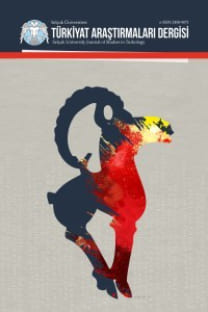Mehmet Eröz’de Türklerde Totemizm İzleri
Mehmet Eröz, Türk kültürünü çok farklı yönleriyle araştırıp kendinden sonra gelensosyologların hizmetine sunmuştur.Türklerde totemizm izleri meselesi, kültür ve toplum tarihindeki konulardan farklıbiri olarak dikkat çekmiştir. Totemizm, sosyoloji ve sosyal antropolojide insanlığın klandevrinden kalma birtakım anlayışlarına verilen addır. Bu anlamda, Eröz, Türklerin deeski yaşayışlarının bir uzantısı olarak totemik anlam taşıyan anlayışlarının var olduğunuöne sürmektedir. Kurt, at, koyun(özellikle koç), güvercin gibi hayvanlar bu anlayışlarınsembolik örnekleridirler.Özellikle Alevî-Bektaşî kültüründeki tavşan eti yememe ve onu uğursuz saymaadetinin bu dönemden kalma totemik iz taşıdığı konusu, Türklerdeki totemik iz taşıyanunsurlar arasında öne çıkmaktadır.
Anahtar Kelimeler:
Totem, totemizm, Türklerde totemizm, Türk Kültürü ve totemizm
MEHMET ERÖZ’S VIEWS ON THE TRACES OF THE TOTEMISM IN THE TURKS
Mehmet Eröz has contributed to Turkis sociology by studying Turkish culture in its different aspects. The problem of totemism in the Turkish culture has been important for the researchers. In sociology and anthropsloyy totemism is seen as a conception of the primitive cultural era of the human society. In this sense, Eröz claims that Turks also had totemistic understanding. Wolf, horse, ram and pigeon are conveyed as the samples of the Turkish totemism. In particular, the rabbit matter in the Alawi and Bektashi culture has represented an interesting pattern of the totemism. In this understanding, the rabbit has is related to bad luck, for that reason, meat of the rabbit is not eaten
Keywords:
Totem, totemism, totemism in the Turks, Turkish culture and totemism,
- ISSN: 1300-5766
- Yayın Aralığı: Yılda 3 Sayı
- Başlangıç: 1994
- Yayıncı: Selçuk Üniversitesi
Sayıdaki Diğer Makaleler
Hâce Hatib Mahmud Er-Rûmî, Eserleri ve Osmanlı İlim Hayatındaki Yeri
Eski Türk ve Rus Geleneklerinin Etkileşim İzleri
Celâl Nuri İleri ve Tarih Anlayışı
Türkçede -ma (-me) Ekinin Yeri
Korkuteli (İstanoz) Tarihi ve Korkuteli Alaaddin Camii Üzerine Bir Araştırma
Yaşar Nabi Nayır’ın Çeviriye Dair Görüşleri
Konya Mânilerinde Geçen Yerleşim Birimlerinin Adlarına Bir Bakış
Karşılaştırmalı Edebiyat Bilimi ve Bir Uygulama
